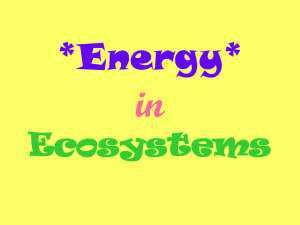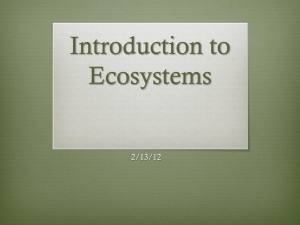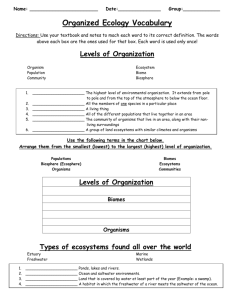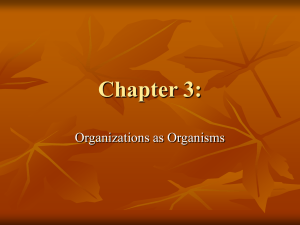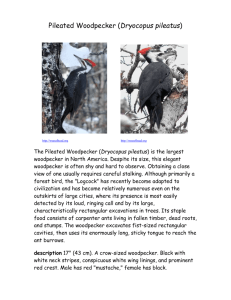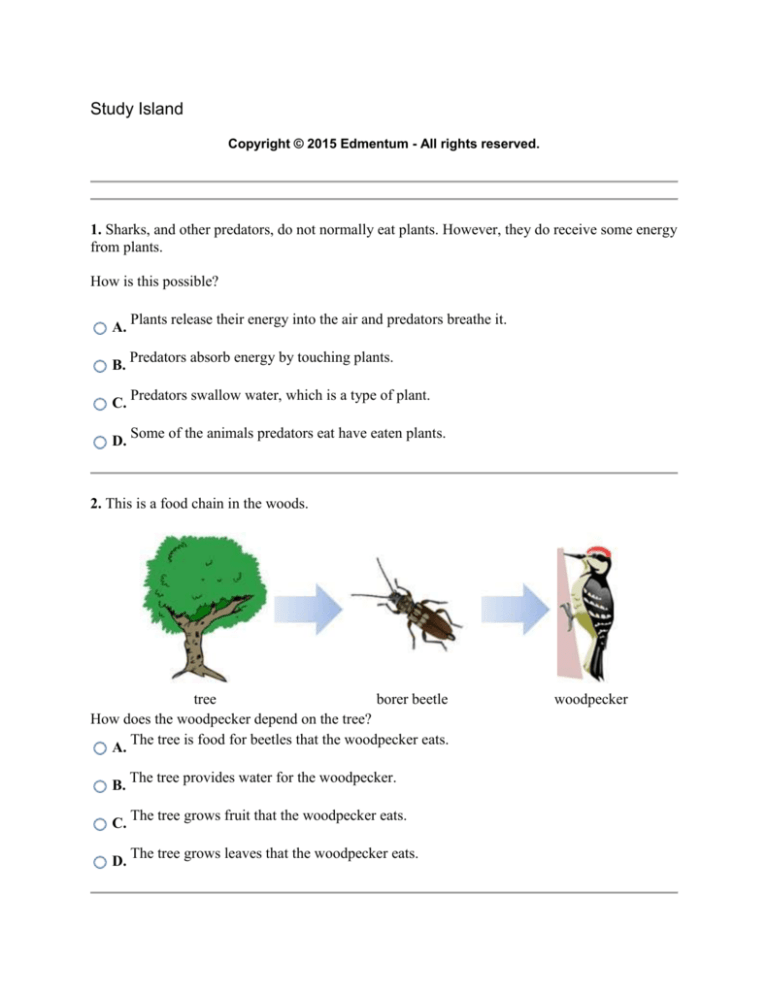
Study Island
Copyright © 2015 Edmentum - All rights reserved.
1. Sharks, and other predators, do not normally eat plants. However, they do receive some energy
from plants.
How is this possible?
A.
B.
C.
D.
Plants release their energy into the air and predators breathe it.
Predators absorb energy by touching plants.
Predators swallow water, which is a type of plant.
Some of the animals predators eat have eaten plants.
2. This is a food chain in the woods.
tree
borer beetle
How does the woodpecker depend on the tree?
The tree is food for beetles that the woodpecker eats.
A.
B.
C.
D.
The tree provides water for the woodpecker.
The tree grows fruit that the woodpecker eats.
The tree grows leaves that the woodpecker eats.
woodpecker
3. Producers usually depend on _______ for food.
A. animals
B. decomposers
C. plants
D. the Sun
4. A hawk flies down to a river, captures a fish, and eats it. Which animal is the prey?
A. neither animal
B. both animals
C. the hawk
D. the fish
5. Bark beetles reproduce beneath the bark of trees. They burrow into the wood and tunnel along
it. They eat some of the wood, leaving behind neat patterns.
Bark beetles rely on trees to
A. protect them from predators.
B. be a source of food.
C. shelter them from the weather.
D. all of these
6.
Study the food chain above. Which of the following organisms does a snake eat?
A. grass
B. a hawk
C. a grasshopper
D. all of these
7. When an organism hunts and kills another organism for food, the organism that gets eaten is
called
A. an herbivore.
B. prey.
C. a predator.
D. a producer.
8. Most of the food that organisms eat can be traced back to _______.
A. plants
B. bacteria
C. animals
D. soil
9.
Karen is a gardener. She depends on her garden for food.
It does not rain very often where she lives. What do the plants in her garden need from Karen?
A. bees
B. sunlight
C. water
D. roots
10. Technology Enhanced Questions are not available in Word format.
11. Which of the following pairs of organisms must eat other organisms for food?
A. zebra and oak tree
B. grass and rabbit
C. giraffe and human
D. hamster and sunflower
12. Technology Enhanced Questions are not available in Word format.
13. Which type of consumer is responsible for putting recycled material back into the soil and
environment?
A. decomposer
B. carnivore
C. none of these
D. herbivore
14. Technology Enhanced Questions are not available in Word format.
15.
Sunlight
Algae
Tadpole
Duck
Which of the following is a consumer in the food chain shown above?
A. tadpole
B. algae
C. sunlight
D. all of these
Answers
1. D
2. A
3. D
4. D
5. D
6. C
7. B
8. A
9. C
10. -11. C
12. -13. A
14. -15. A
Explanations
1. Sharks receive some plant energy because some of the animals they eat have eaten plants.
Some organisms eat the plants directly, while other organisms eat animals that have eaten the
plants. However, all organisms depend on plants.
2. In the food chain, the beetle eats the wood and the woodpecker eats the beetle. The
woodpecker depends on the tree because the tree is food for insects that the woodpecker eats.
Without the tree, there would be no insects for the woodpecker to eat.
The tree depends on the woodpecker too. The woodpecker keeps the beetles from eating too
much wood and hurting the tree.
3. Producers do not depend on any other organisms for food. They make their own food,
depending only on the Sun, water, and carbon dioxide.
4. An organism that gets hunted and eaten by another organism is called prey. In this example,
the fish is the prey.
5. Bark beetles depend on trees for all of these things that they need to survive:
The bark protects the beetles from the weather.
Hiding beneath the bark makes it hard for predators to get to the beetles.
The beetles eat the wood of the tree.
6. The red arrows show the direction the energy flows in the food chain. Energy flows from the
grasshopper to the snake. This means that a snake eats a grasshopper in order to get the energy
it needs to grow and thrive.
7. An organism that gets hunted and eaten by another organism is called prey.
8. Plants are producers, which make their own food. Other organisms, such as rodents, birds, and
wild cats, are consumers, which receive their energy from plants or other consumers (which get
energy from plants). Thus, the food that most organisms eat can be traced back to plants.
9. Organisms can depend on each other. The plants depend on the gardener for water because it
does not rain very often.
The gardener also depends on the plants for food.
10. -11. Almost all plants can use light energy to make their own food. Animals, including humans,
cannot make their own food. They must get food by eating at least parts of other organisms.
Giraffes and humans are examples of animals that must get food by eating other organisms.
Giraffes eat tree leaves. Humans eat a wide variety of plants and animals.
When animals eat other organisms, energy stored in the organisms being eaten is passed on to
the animals.
12. -13. Decomposers break down dead animals, plants, and organic matter and recycle the nutrients
back into the environment to be used again.
14. -15. A food chain shows how energy is passed from organism to organism. The arrows in food
chains show the direction of the flow of energy.
Consumers are organisms that cannot produce their own food and must feed upon other
organisms. In this food chain, the tadpole and duck are consumers because they feed upon other
organisms.


